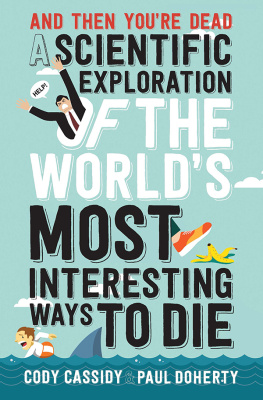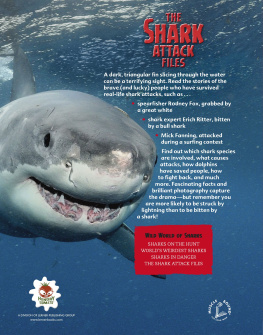
This book could not have been written without the enormous help of many creative, extremely generous people. Drafting an entire list of names would be impossible in this space, but we would be remiss to not mention a few people who deserve special recognition.
Thanks to family and their tremendous advice on everything from the Oxford comma to the title; to friends and their willingness to be peppered with questions both silly and serious; to the great teachers in our lives, both in school and in discussions around tables, in living rooms, around campfires, and online.
Thanks to Kevin Plottner for his talents in drawing icons and then killing them. Thanks to Alia Habib and the folks at McCormick for taking a chance. And thanks to our editor, Meg Leder, and the entire team at Penguin for their assistance at every turn.
L IKE MOST PEOPLE who have traveled in a modern airplane, you have probably spent a good bit of time staring out the window at the lovely clouds, sunsets, and beautiful views. And, like most people, you have probably wondered, what happens if this thing pops out?
The answer depends on your altitude. If you were within the first few minutes of flight and still under 20,000 feet, you would probably be okay. You could still breathe for a half hour before you passed out at that altitude, and the pressure difference wouldnt be great enough to suck you out. It would be a little chilly, but as long as youre wearing a sweatshirt you should be fine.
It would also be noisy. The wind blowing past your open window would turn the plane into the worlds largest flute, so getting the attention of a flight attendant would be a problem. All in all, though, not bad, and a lot better than if the window popped out at a cruising altitude of 35,000 feet.
The air inside a planes cabin is pressurized to around 7,000 feet because of the whole breathing thing. If youre at 35,000 feet and the window pops out, the plane rapidly depressurizes, and that leads to some issues.
The first thing you would notice is all the air getting sucked out of every orifice in your body. And because its humid air, it would condense and come out as a fog. That would happen to everybody, so the entire plane would be a thick fog of everyones body air. Gross.
Fortunately that would clear up in a few seconds, because the air in the plane is getting sucked out of the open window. Unfortunately, its not a neighbors window, its yours, and that makes a big difference.
If you were sitting just two seats away from the missing window, the wind would be rushing out of the plane with hurricane speed, but thats still slow enough that if you were wearing a seat belt you would be held fast. Unfortunately, you chose the window seat, where the air would rush out at 300 miles per hourfast enough to pull you up and out of your seat even if youre strapped in. (One of the less-mentioned cons of choosing the window over the aisle.)
Another reason your friend in the aisle seat would be saved is because airplane windows are smaller in diameter than your shoulders. According to research by Harvard University on the human body, the average American has 18-inch-wide shoulders, and the Boeing 747 aircrafts windows are only 15.3 inches tallso you would not be sucked all the way out of the plane, just partway. Thats good for everyone in the plane. It would save you from a long fall, for one, and for everyone else your body would serve as a decent plug. It would slow down the airs escape from the plane and give people more time to put on their oxygen masks.
Your troubles, on the other hand, would only be beginning.
The first thing you might notice about your new environment would be the wind. The 600-miles-per-hour gale blasting you in the face would push you against the aircraft, wrapping you in a J-shaped figure around the side of the plane.
The second thing you would notice would be the cold. The temperature at 35,000 feet is 65 degrees below zero. In that chill your nose would become frostbitten within a few seconds.
The third issue is not something you would notice but is probably the most life-threatening. In addition to the abrupt drop in temperature, there would be a more serious change in air pressure. At 35,000 feet the air is so thin you wouldnt get enough oxygen molecules per breath to survive, only you would not know you were suffocating. Your body cannot detect when theres too little oxygen; the only thing that gives you that running-out-of-breath feeling is too much carbon dioxide in your blood. So you would keep breathing like everything was fine, but it wouldnt be. You would have less than fifteen seconds of consciousness before you passed outand four minutes before brain death.
That goes for people inside the plane as well. As soon as your window popped out they would have fifteen seconds to put on their masks before they passed outmaybe a bit more if your upper body formed a good seal on the windowand really only eight seconds before their brains became so oxygen starved they would be too confused to put on their masks.
So to recap, you would be halfway out of the airplane, your face would be slamming against the side of the plane, you would have frostbite, and you would be on your way to unconsciousness. But you wouldnt be dead yet and, surprisingly, if the pilot acted quickly and got down below 20,000 feet within four minutes, you might survive the experience. We know this because its happened.
Captain Tim Lancaster was climbing past 20,000 feet in his British Airways flight in 1990 when the front windscreen popped off. He was immediately sucked out of his seat belt and out the window. Everything loose in the cockpit flew out and the flight door jammed into the controls, sending the plane into a steep dive. Nigel Ogden, a flight attendant who happened to be in the cockpit, managed to grab the pilot on his way out and reported the following to the Sydney Morning Herald:
Everything was being sucked out of the aircraft: even an oxygen bottle that had been bolted down went flying and nearly knocked my head off. I was holding on for grim death but I could feel myself being sucked out, too. John rushed in behind me and saw me disappearing, so he grabbed my trouser belt to stop me slipping further, then wrapped the captains shoulder strap around me...
I thought I was going to lose him, but he ended up bent in a U-shape around the windows. His face was banging against the window with blood coming out of his nose... and his arms were flailing.
Eighteen minutes after losing the windscreen the copilot managed to land the aircraft, with his pilot staring at him from the other side of the window the entire time.
Somehow, after firefighters managed to extract the pilot from his awkward position, he survived with only frostbite and a few broken ribs.
Because of the smaller window, you may not need to rely on heroics from your fellow passengerswith just quick action from your pilot, you could enjoy an uncomfortable but scenic trip down.
Why do a few feet make such a difference? Picture it this way: When you plug up your bathtub, the power of the water sucking the plug into place gets exponentially greater the closer it gets. Same thing when it comes to airplane windows, and youre the plug.
This is where real life differs from the James Bond movie Goldfinger. Goldfinger would not have been sucked out of the window; he just would have been stuffed into it.
Instead of being pressed into the plane, you would bang against it because of something called reverberation dynamics, which is the same principle that explains a flag flapping in the wind instead of being held in one position. Even if it seems like the wind is constant, it isnt, and the flag is in a perpetual state of change and adjustment. Your changes and adjustments would be your face slamming against the aircraft repeatedly.
Next page






